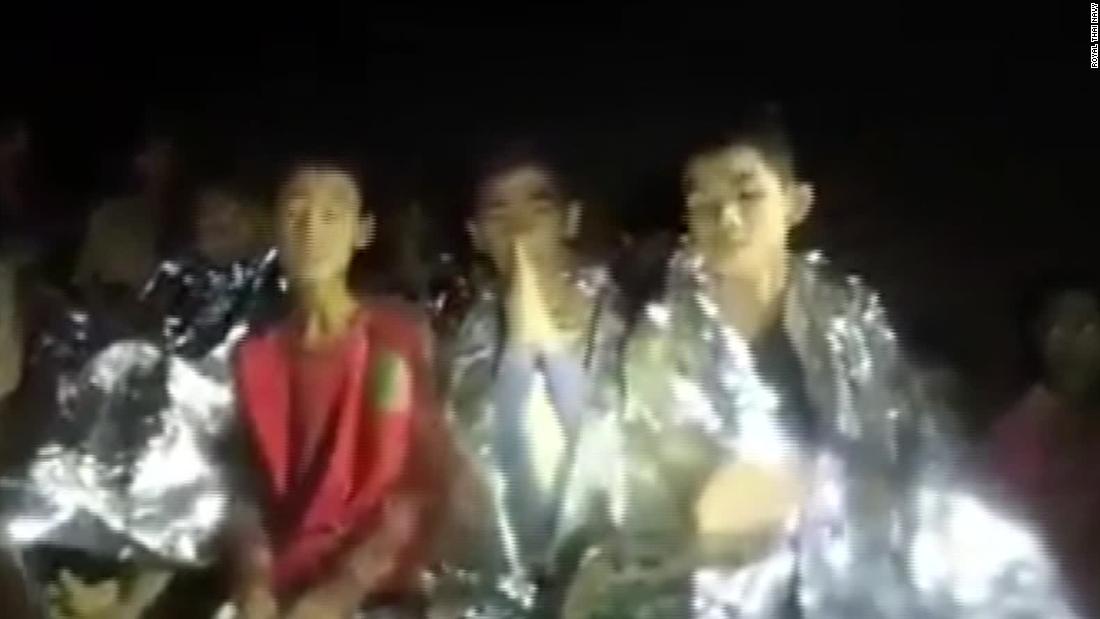[ad_1]
New video released by the Thai Navy SEALs Wednesday shows the boys wrapped in foil blankets for warmth, as they speak up one by one, introducing themselves and saying “I am healthy.” One says “thank you” to everyone who is waiting for their rescue.
While several solutions have been considered since the team was found huddled in a cavern Monday night, rescuers are working on a plan to evacuate the boys, aged 11 to 16, and their 25-year-old coach, through the narrow, flooded tunnels, in full-face diving masks.
In a press conference Wednesday morning, Chiang Rai governor Narongsak Osottanakorn said it would be “difficult” to bring them out Wednesday. He said he didn’t want to provide an estimate on when they could be brought out and reunited with their families.
“All I can say is everyone is working very hard here. Everyone is working their hardest. They haven’t rested since day one.”
To keep the boys’ spirits up, authorities are attempting to set up phone lines inside the cave to allow them to talk to their parents.
However, attempts to install the cables have been unsuccessful so far, Maj. Gen. Bancha Duriyaphan said, as one of the cables suffered water damage while divers transported it “around small passages.” Teams are attempting to take in a new one.
“When the telephone line is ready, we will have relatives talk to them. The pressure will be immensely reduced,” Maj. Gen. Chalongchai Chaiyakum, another military spokesman, said.
Ticking clock
It’s now been over 36 hours since the boys were first located by two British divers, and while SEAL divers have been able to reach them with food and medicine, conditions mean it’s currently too risky to bring them out the way the divers have come in.
It’s is a long, hazardous dive, even for the experienced Navy SEAL divers who are now in contact with the group.
Seven of the navy team, including a doctor and nurse, spent Tuesday night huddled in the dark with the boys and their coach, who have been trapped inside the cave since June 23. The insignia of the SEALs has been etched onto a rock face in the cave, video from the group’s Facebook page shows.
Initial medical check-ups showed the boys were in good health, and video showed some being treated for scrapes and mild rashes.
The divers are making the complicated dive back and forth to the small, cramped shelf where the boys are sheltering deep within the flooded cave complex and are feeding the group high-protein gels to get their strength up.
The focus is on getting the children ready for the dangerous journey ahead. On Wednesday, the children — some of whom can’t swim — practiced wearing the full-face oxygen masks they’ll need to wear to survive the journey out.
They’ve tried wearing the equipment and breathing with it on, but haven’t yet been submerged in the flood water, Osottanakorn said, as the currents are too strong.
The plan is to bring the boys out at different times, depending on their strength.
“They don’t have to leave all at once. Those who are ready can come out first. We are reassessing the situation daily. We have to see they are ready. Therefore if we found any risk we wont carry out the (evacuation) plan,” he added.
However, there remains a sense of urgency, as the unpredictable weather and the threat of further heavy rains that could further flood the chambers. The governor said water is still being pumped out of the cave “at full speed” to reduce water levels further.
The outflow has caused problems downstream, with some 200 families reporting that their rice paddies had been affected. But, far from complaining, they, like the rest of the country, are happy that the boys have been located and positive action taken to retrieve them.
A few days of relatively fine weather have given rescuers a window to prepare for the moment the boys eventually emerge from the cave. Soldiers dressed in green fatigues practiced evacuation drills, linking arms to form a human wall around the mouth of the cave, to offer protection for a time when the boys brought out into the open air and transferred to waiting ambulances.
Difficult rescue
Debate remains over the best way to bring the boys to safety.
Given their weakness after a week with no food, trapped in the dark, and their unfamiliarity with scuba systems, some experts say it’s too difficult to bring a group of novices through a cave system that has made even caving experts nervous.
Cade Courtley, a former US Navy SEAL and author of the “SEAL Survival Guide” told CNN that he “was part of a very special dive unit and this would be a challenging dive for me and my team… now you’re going to ask 11 to 15-year-olds — some of whom cannot swim — to make that same journey for the first time breathing air underwater?”
He says that bringing the team out the way that the divers reached them would be the “most dangerous” option.
“The most dangerous is trying to teach them enough diving skills to dive them out. It’s physically strenuous: in water, through blackout conditions, through tight squeezes for hundreds of meters.
“It’s something that skilled cave divers spend hundreds of hours training for after they have already been open water divers for quite some time. A moment of panic or loss of the breathing regulator can be fatal for the novice diver, and may also put the cave diver escorting him in danger.”
[ad_2]
Source link




